According to respected veterinarian Dr Tom Lonsdale, pet owners are being fooled into believing that the processed pet food they feed their dogs and cats is healthy and nutritious when, in fact, it could be responsible for a global pet illness pandemic and costing huge sums in unnecessary visits to the vet.
Based on more than three decades of research, Dr Lonsdale says that industrialised ‘junk pet food’ is directly linked to gum disease in dogs and cats, and that this condition goes far beyond foul breath, leading to serious, potentially life-limiting diseases such as diabetes, cancer, arthritis, liver, kidney, and heart disease. In its place, he says, we should feed dogs and cats raw meaty bones, which he describes as both nutritious and medicinal – and perfect for keeping our pets in tip-top condition.
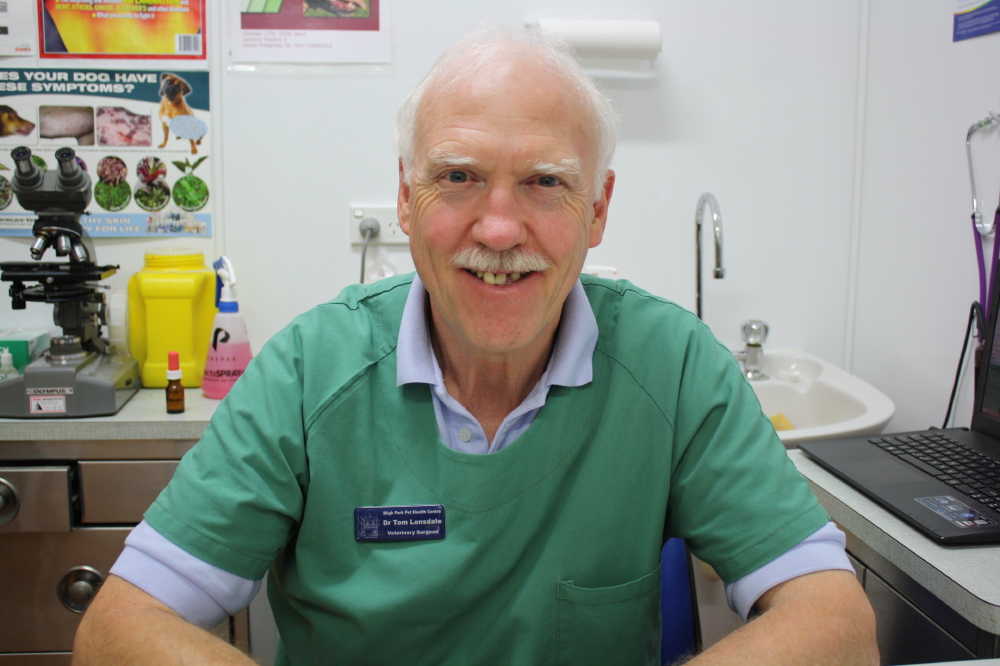
Dr Tom Lonsdale’s message is as urgent as it is astonishing and needs to be heard by pet owners everywhere. To mark the publication of his new book, Multi-Billion-Dollar Pet Food Fraud: Hiding in Plain Sight, an explosive exposé of the ‘junk pet food’ industry, we caught up with the ‘whistleblower vet’ to find out more.
Q. How did you first discover that pet dogs and cats were suffering from a lack of raw meaty bones in their diet?
A. As a veterinary student, I never gave the matter a moment’s thought – despite the need for raw meaty bones as the defining characteristic of carnivores, whether wild or domestic. My veterinary school in the 1970s had nothing to say on the matter and I believe that vet schools are similarly disposed today.
It was another 15 years after graduation that I began to question why the majority of my patients had stinky breath and most needed dental treatment too. Discussion with colleagues and trial-and-error enabled me to figure out the frequency and quality of raw meaty bones feeding necessary for the maintenance of good oral health in pets.
Q. How do meaty bones benefit the health of pet dogs and cats?
A. Put another way, without raw meaty bones pets cannot be healthy.
Physically, canned and packaged products don’t clean teeth and don’t stimulate appropriate gastro-intestinal secretions. In fact, the products specifically contaminate the teeth – with disastrous long-term effects. The industrial products are mostly cooked grains and assorted chemicals that sit undigested in the gastrointestinal tract for hours. Effectively, then, junk food fed pets suffer constant harm 24 hours a day, every day for life.
Raw meaty bones do not harm pets. In fact, they provide all the necessary nutrients in digestible form for best growth, maintenance, and repair. Raw meaty bones provide the vital texture necessary to stimulate the brain, clean the teeth and massage the gums and generally tone the gastro-intestinal tract.
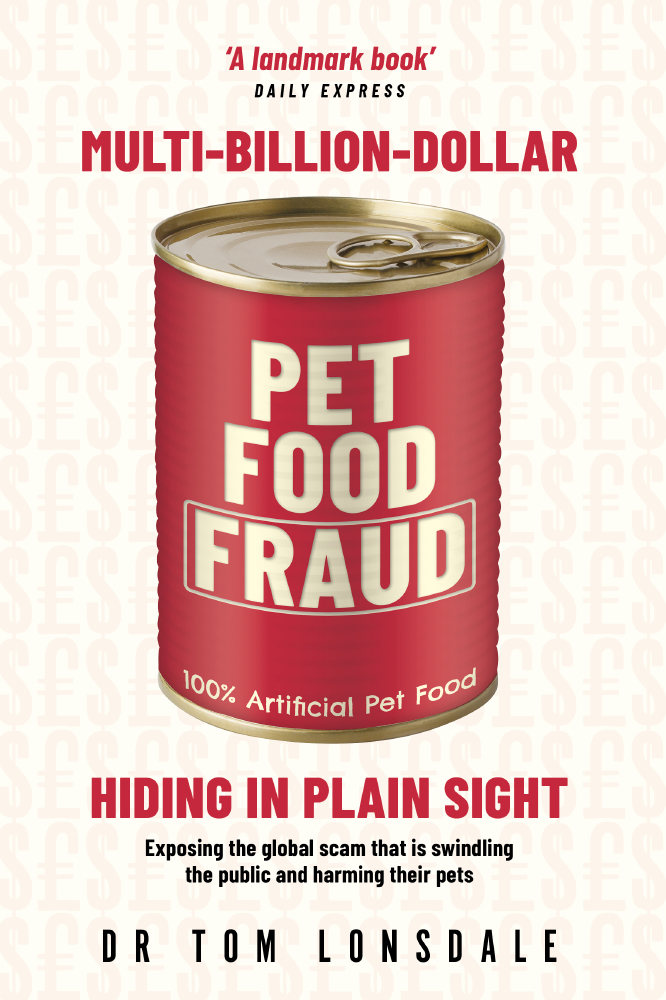
Q. You say that raw meaty bones can also affect a pet’s temperament and behaviour. Can you explain more?
A. Useful information can be derived from the observations of dog trainers and pet owners who report on the sometimes-remarkable changes in temperament of dogs and cats when converted from a junk food to a raw meaty bones diet.
From first principles we know that pets fed junk food have sore and diseased gums. The pain from sore gums and the toxins perfusing the body, including the brain, must have a significant effect.
Similarly, the breakdown products of cooked grains very likely are another source of brain fog for animals that are supposed to consume a meat-based diet. Then consider that kibble remains dry and immovable in the stomach of carnivores for many hours. The lower intestine is distended by the previous day’s meal. From one end to the other, the carnivore’s digestive tract is abused by junk food.
For these reasons, we should not be surprised if dogs and cats feel chronically unwell, quite likely in pain and irritable. Unfortunately, thousands, perhaps millions of children bear the scars of dog and cat bites.
Q. How soon should an owner introduce raw meaty bones into a pet’s diet, and how often should they feed them raw meaty bones each week?
A. Start the very first day of ownership. Raw meaty bones principles should apply every day of every week. However, on some days feeding lumps of offal will be appropriate. On other days, fasting and no food is best. Generally, though, a large lump of raw meaty bones should be fed most days.
Regarding the optimum commencement time, that should follow nature’s guidance. Ideally, puppies and kittens should be introduced to raw meaty bones whilst still in the nest from about four weeks of age. Initially they lick and suck the meat and by six weeks of age they can crunch the bones.
Q. Do pet owners still need to feed their pets other food or treats alongside raw meaty bones to provide adequate nutrition?
A. In 30 years, I’ve seen no difference between dogs and cats fed whole carcasses and raw meaty bones. However, raw meaty bones-fed pets outstrip junk food-fed animals by every measure.
Regarding ‘treats’ a few dried liver or similar treats do no harm and may be beneficial.
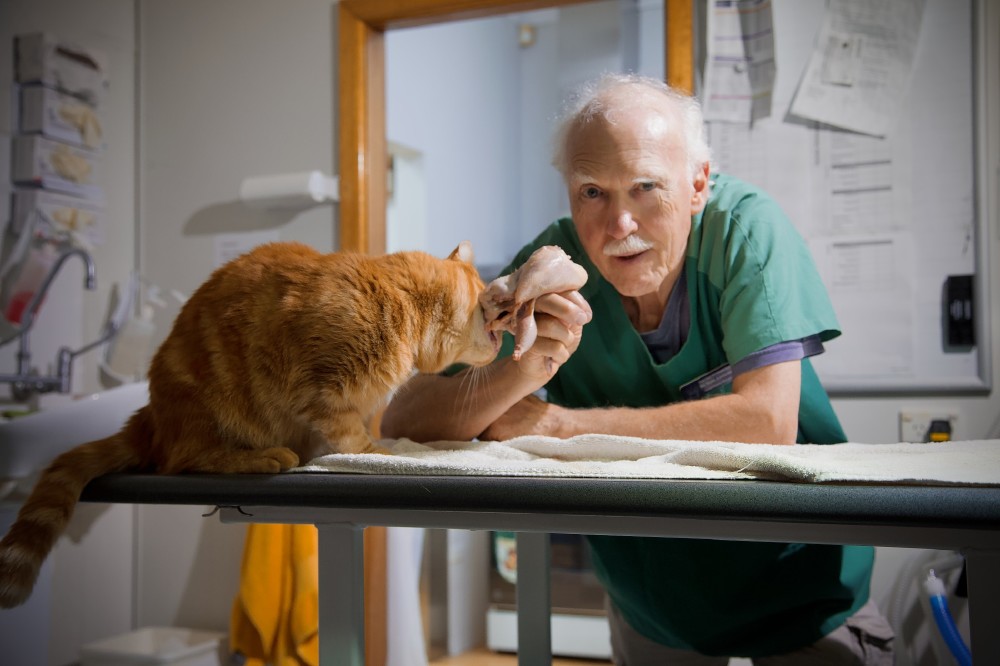
Q. Why do you think that many pet food manufacturers and many vets are not advocating raw meaty bones to pet owners?
A. Existing business models favour the massive processing and marketing of grain-based canned and packaged products. Billions of dollars are made.
To my knowledge, all vet schools are living a lie, founded on the fallacy that junk pet food is appropriate for modified wolves and cats. All vet schools, to my knowledge, receive junk pet food company funds. It’s the oil and grease that keeps the brainwashing machine churning out pre-programmed vets. The thought police are out in force and those vets that escape the police are restrained by their own self-censorship.
Effectively, then, the vet profession is lost without a moral compass, adrift on a sea of lies. Masquerading as a pet’s best friend, in my opinion, most vets are a pet’s worst enemy. Telling the truth results in healthy pets and little or no need for the vet.
Q. Can any type of bone work for feeding pets?
A. Start from the fundamentals. Think about what a cat or dog, if living in the wild, would be likely to catch and eat. All bones come covered with plenty of meat. Wolves in the wild eat the ribs and gnaw the ends of long bones. But they leave the head, spine, and long bones uneaten. That should inform how we feed our domestic, modified wolves. Suitable foods are lamb ribs, ox tail, whole chickens, and fish.
Cats in the wild catch rabbits and birds. They start by eating the head of a rabbit. All bones of birds are eaten. In domestication, chicken, quail, duck, and fish are all excellent foodstuffs for cats.
Q. Isn’t there a risk that feeding a pet a bone might lead to choking?
A. Raw meaty bones are the safest, strongest most gentle ‘medicine’ available for pet dogs and cats. However, as with any medicine, there are potential risks. The more the bones are processed, the greater the hazard. Large, hard bones break teeth, tend to splinter and can penetrate internal organs. Chopped bones cut into small pieces are more easily swallowed and can get stuck.
In my experience, the most common foreign body obstruction in dogs arise from corn cobs, peach stones … and tampons.
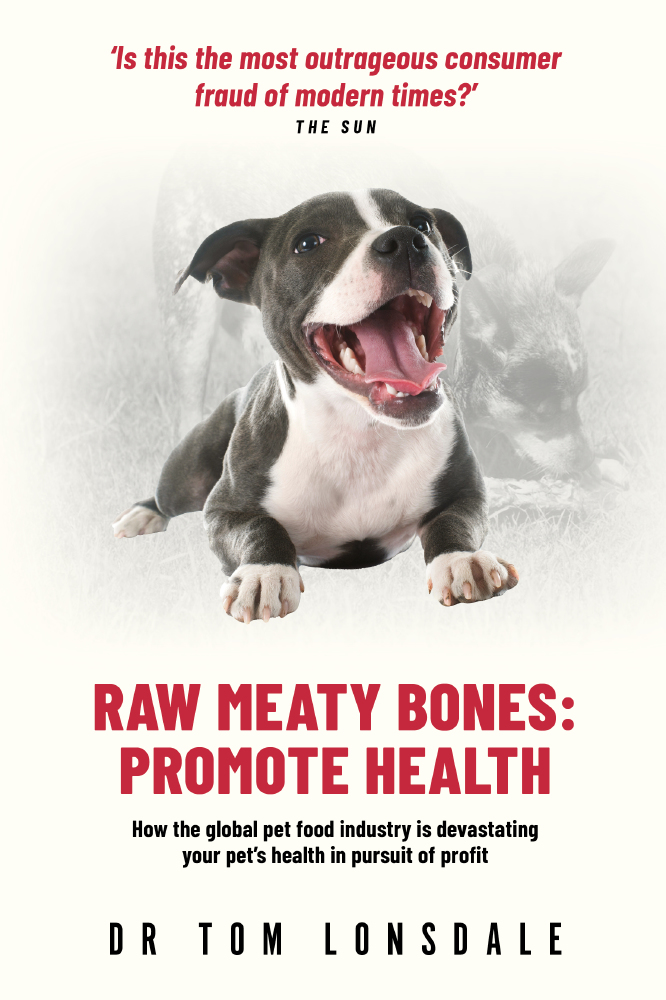
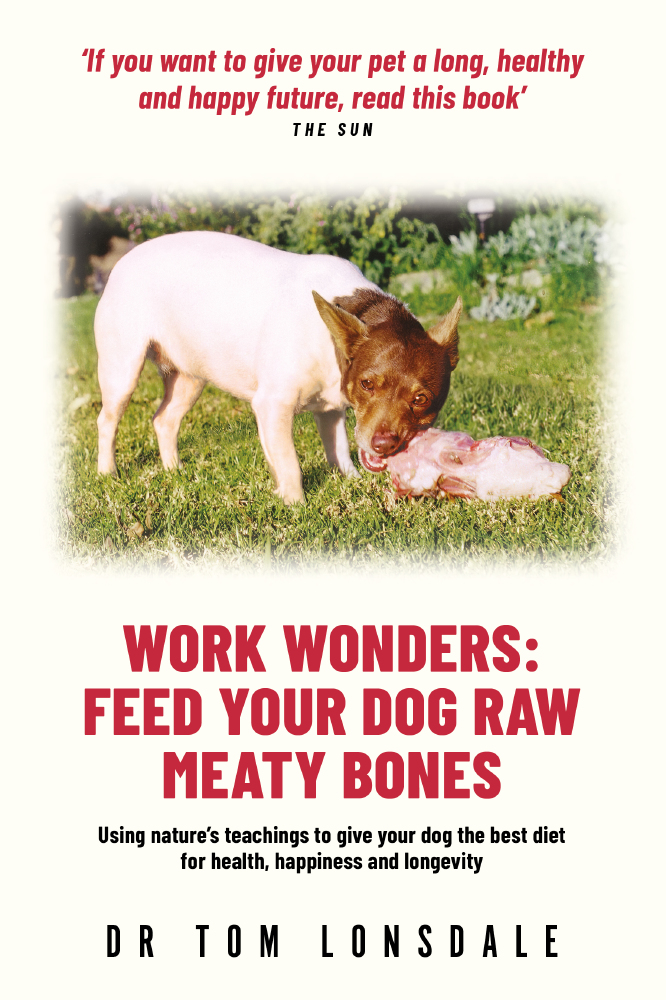
Q. Why can’t pet owners clean their pets’ teeth instead of feeding them raw meaty bones?
A. It's a complete fantasy to suggest that manual tooth brushing can begin to mimic the thorough nature’s way of cleaning teeth and massaging gums.
Even if toothbrushing were a practical option, it would be negligent in the extreme to continue to harm a pet with the junk pet food ingredients whilst pretending that a useful intervention had been successfully employed.
Q. Aside from improving pets’ health, what other benefits come from swapping ‘junk pet food’ for raw meaty bones?
A. For pets, the big benefit is their health. For their human carers, the benefits are legion. Every day they realise that they’re doing the best for their pets. They marvel at the sounds and sights of pets enjoying their food and medicine. They are constantly reminded that natural food is best; they resolve to buy more fruit and vegetables and less meat for themselves. They see the benefits of proper teeth cleaning and flossing and resolve to be more fastidious with their own dental hygiene.
They notice that the pets’ breath does not reek and neither does the excrement. They notice that the pets seem more contented, don’t pace around aimlessly and sleep more soundly. Of course, all the bothersome chronic diseases of skin and bowel are reduced or disappear. They notice the reduction in need to visit the vet, whether for chronic or serious diseases. Clearly the reduction in vet fees is a major plus.
Multi-Billion-Dollar Pet Food Fraud: Hiding in Plain Sight by Dr Tom Lonsdale is available on Amazon in paperback, eBook, and audiobook formats, priced £13.59, £7.99 and £8.48 respectively. For more information, visit www.thepetfoodcon.com or follow Dr Lonsdale on YouTube.

